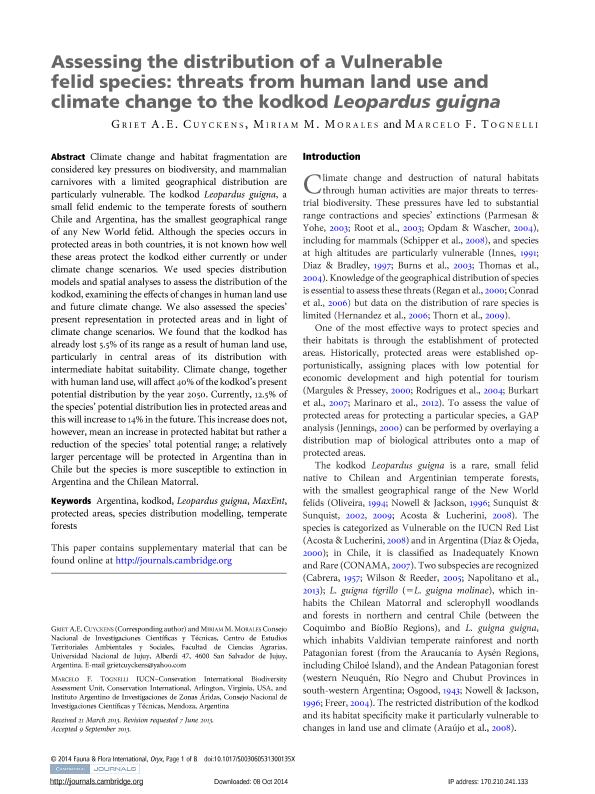Artículo
Assessing the distribution of a Vulnerable felid species: threats from human land use and climate change to the kodkod Leopardus guigna
Fecha de publicación:
10/2014
Editorial:
Cambridge University Press
Revista:
Oryx
ISSN:
0030-6053
Idioma:
Inglés
Tipo de recurso:
Artículo publicado
Clasificación temática:
Resumen
Climate change and habitat fragmentation are considered key pressures on biodiversity, and mammalian carnivores with a limited geographical distribution are particularly vulnerable. The kodkod Leopardus guigna, a small felid endemic to the temperate forests of southern Chile and Argentina, has the smallest geographical range of any New World felid. Although the species occurs in protected areas in both countries, it is not known how well these areas protect the kodkod either currently or under climate change scenarios. We used species distribution models and spatial analyses to assess the distribution of the kodkod, examining the effects of changes in human land use and future climate change. We also assessed the species’ present representation in protected areas and in light of climate change scenarios. We found that the kodkod has already lost 5.5% of its range as a result of human land use, particularly in central areas of its distribution with intermediate habitat suitability. Climate change, together with human land use, will affect 40% of the kodkod's present potential distribution by the year 2050. Currently, 12.5% of the species’ potential distribution lies in protected areas and this will increase to 14% in the future. This increase does not, however, mean an increase in protected habitat but rather a reduction of the species' total potential range; a relatively larger percentage will be protected in Argentina than in Chile but the species is more susceptible to extinction in Argentina and the Chilean Matorral.
Archivos asociados
Licencia
Identificadores
Colecciones
Articulos(SEDE CENTRAL)
Articulos de SEDE CENTRAL
Articulos de SEDE CENTRAL
Citación
Cuyckens, Griet An Erica; Morales, Miriam Mariana; Tognelli, Marcelo Fabio; Assessing the distribution of a Vulnerable felid species: threats from human land use and climate change to the kodkod Leopardus guigna; Cambridge University Press; Oryx; 49; 4; 10-2014; 611-618
Compartir
Altmétricas




